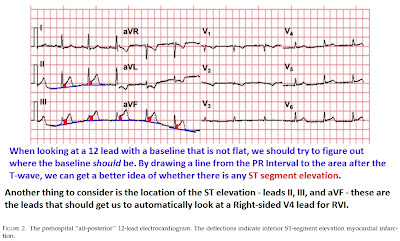
–
On the most recent Standing Orders podcast, EMSSO Episode 6: “Posteriorly Speaking” – A novel use of the pre-hospital 12 lead includes Russell Stine, Brad Buck, Matt Fults, Dr. Chris Russi D.O. and I discuss a case study published by Dr. Russi.
–
This is an excellent case study, because it demonstrates a paramedic using his judgment, rather than tryhing to make the patient fit a protocol. This is –
a morbidly obese man (206 kg) with a blood pressure of 104/68 mmHg, a regular pulse of 68 beats/min, and a respiratory rate of 40 breaths/min.[1]
The paramedic, Kevin Steever did a great job of thinking while treating the patient. He did not waste time on scene with this patient, but began moving to the hospital and obtained a posterior 12 lead on the move. The information obtained was useful and relevant to the treatment of this patient.
Here is the timeline for the call. The times I want to draw your attention to EMS-wise is the scene time. 12 minutes may not seem that quick for a scene time with a chest pain patient, but this is a 206 kg patient – that means just over 453+ pounds. This is a case of keeping things moving, but not forgetting about patient care.
–
He refused to be placed supine or in the Fowler position (seated) owing to severe back pain and weakness, so he was lifted to the stretcher and transported in the prone position in the ambulance.[1]

Click on the images to make them larger.
–
What kind of 12 lead can be expected from a posterior 12 lead?
An atypical 12 lead, but we can still see most of what we are looking for.
What about the size of the patient?
The size and the positioning will probably produce smaller everything on the ECG – including a smaller amount of ST elevation than would be obtained with a standard 12 lead. There is more insulation between the heart and the leads.
–
–
Some people will tell you that you cannot tell anything with a baseline that is not flat, but that is not true. When looking for ST elevation, we tend to ignore the shape of the change at the J point (the point from where ST elevation is measured). There is a noticeable difference between a normal and abnormal 12 lead. That does not mean that this is diagnostic for a STEMI, but it should keep us looking at STEMI as a possibility and encourage involvement of a cardiologist in evaluation of the abnormal ECG.
–
A right-sided ED ECG (not shown) did not provide evidence of right ventricular infarct.[1]
–
To give an idea of the placement of the electrodes on this patient, they had someone pose for this picture. The leg leads are not on the legs and the arm leads are not on the arms, because the differences are with all of the precordial leads. The arm and leg leads should be placed just as we would place them if the patient were lying on his back.
–
–
Go listen to the whole podcast.
–
Footnotes:
–
[1] Prehospital diagnosis of ST-segment elevation myocardial infarction using an “all-posterior” 12-lead electrocardiogram.
Russi CS, Myers LA, Kolb LJ, Steever K, Nestler DM, Bjerke MC, White RD, Ting HH.
Prehosp Emerg Care. 2011 Jul-Sep;15(3):410-3. Epub 2011 Apr 4.
PMID: 21463202 [PubMed – in process]
.





[…] may have caused your symptoms are major factors in diagnosis and treatment. Written by Jay JeffersAcute or Chronic Back Pain It`s Causes And Treatment Suffering from Acute or Chronic back pain is on…pain-300×274.jpg" alt="" width="300" height="274" />Suffering from Acute or Chronic back pain is one […]